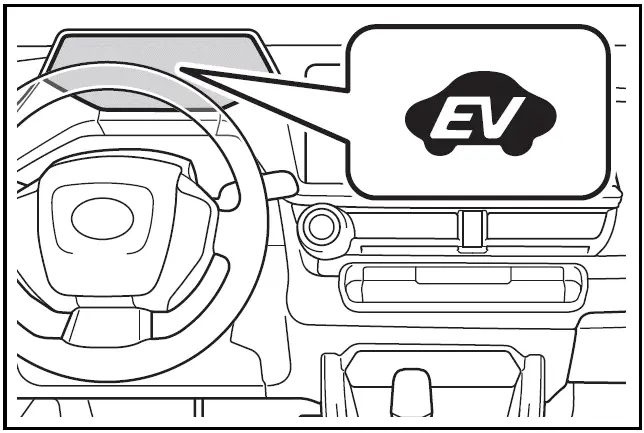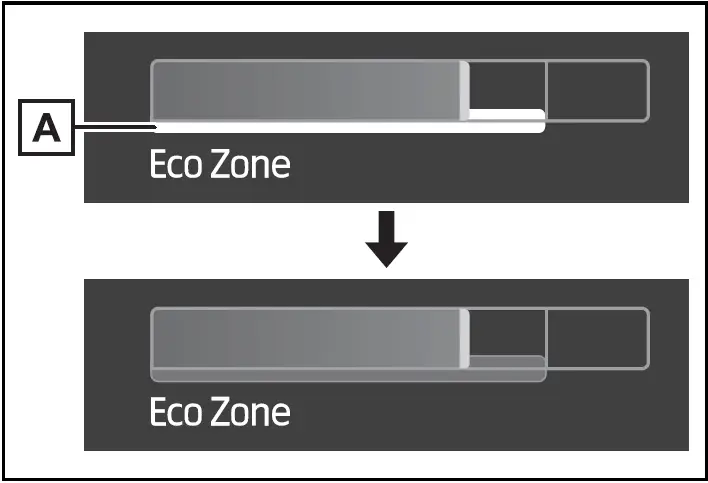Toyota Prius: Hybrid system features
Toyota Prius boasts an advanced hybrid system that incorporates several key features designed to enhance fuel efficiency, performance, and environmental friendliness.uel, and then restarts it seamlessly when the driver accelerates.
System components
Your vehicle is a Hybrid Electric Vehicle, which has unique characteristics compared to conventional vehicles. It is important to familiarize yourself with these characteristics and operate your vehicle with care. The hybrid system seamlessly integrates a gasoline engine with an electric motor (traction motor), adjusting their use based on driving conditions to enhance fuel efficiency and reduce exhaust emissions.
System components

The illustration is an example for explanation and may differ from the actual item.
- Gasoline engine
- Front electric motor (traction motor)
- Rear electric motor (traction motor) (AWD models)
When stopped/during start off
The gasoline engine stops* when the vehicle is stopped.
During start off, the electric motor (traction motor) drives the vehicle. At slow speeds or when traveling down a gentle slope, the engine is stopped* and the electric motor (traction motor) is used.
When the shift position is in N, the hybrid battery (traction battery) is not being charged.
*: When the hybrid battery (traction battery) requires charging or the engine is warming up, etc., the gasoline engine will not automatically stop.
During normal driving
The gasoline engine is predominantly used. The electric motor (traction motor) charges the hybrid battery (traction battery) as necessary.
When accelerating sharply
When the accelerator pedal is depressed heavily, the power of the hybrid battery (traction battery) is added to that of the gasoline engine via the electric motor (traction motor).
When braking (regenerative braking)
The wheels operate the electric motor (traction motor) as a power generator, and the hybrid battery (traction battery) is charged.
Regenerative braking
In the following situations, kinetic energy is converted to electric energy and deceleration force can be obtained in conjunction with the recharging of the hybrid battery (traction battery).
- The accelerator pedal is released while driving with the shift position in D or B.
- The brake pedal is depressed while driving with the shift position in D or B.
EV indicator
The EV indicator comes on when the vehicle is driven using only the electric motor (traction motor) or the gasoline engine is stopped.
The 2024 Toyota Prius features an EV indicator that lights up when the vehicle is operating in Electric Vehicle (EV) mode. This mode allows the Prius to run solely on electric power, provided the battery charge is sufficient and driving conditions are optimal, such as low-speed, short-distance driving. The EV indicator helps drivers monitor when the vehicle is using electric power only, contributing to fuel savings and reduced emissions. This visual cue allows for more conscious and efficient driving, maximizing the benefits of the hybrid system.
The on/off operation of the EV indicator can be changed.

Conditions in which the gasoline engine may not stop
The gasoline engine starts and stops automatically. However, it may not stop automatically in the following conditions*:
- During gasoline engine warm-up
- During hybrid battery (traction battery) charging
- When the temperature of the hybrid battery (traction battery) is high or low
- When the heater is switched on
*: Depending on the circumstances, the gasoline engine may also not stop automatically in other situations.
Charging the hybrid battery (traction battery)
As the gasoline engine charges the hybrid battery (traction battery), the battery does not need to be charged from an outside source. However, if the vehicle is left parked for a long time the hybrid battery (traction battery) will slowly discharge. For this reason, be sure to drive the vehicle at least once every few months for at least 30 minutes or 10 miles (16 km). If the hybrid battery (traction battery) becomes fully discharged and you are unable to start the hybrid system, contact your Toyota dealer.
Charging the 12-volt battery
After the 12-volt battery has discharged or when the terminal has been removed and installed during exchange, etc.
The gasoline engine may not stop even if the vehicle is being driven by the hybrid battery (traction battery).
If this continues for a few days, contact your Toyota dealer.
Sounds and vibrations specific to a Hybrid Electric Vehicle
Because there is no engine sound or vibration, it is easy to mistake the hybrid vehicle for being off when it is actually still running, as indicated by the "READY" indicator being illuminated.
For safety, make sure to always shift the shift position to P and apply the parking brake when parked.
The following sounds or vibrations may occur when the hybrid system is operating and are not a malfunction:
- Motor sounds may be heard from the engine compartment.
- Sounds may be heard from the hybrid battery (traction battery) under the rear seats when the hybrid system starts or stops.
- Relay operating sounds such as a snap or soft clank will be emitted from the hybrid battery (traction battery), under the rear seats, when the hybrid system is started or stopped.
- Sounds from the hybrid system may be heard when the back door is open.
- Sounds may be heard from the transmission when the gasoline engine starts or stops, when driving at low speeds, or during idling.
- Engine sounds may be heard when accelerating sharply.
- Sounds may be heard due to regenerative braking when the brake pedal is depressed or as the accelerator pedal is released.
- Vibration may be felt when the gasoline engine starts or stops.
- Cooling fan sounds may be heard from the air intake vent under the rear seat.
Maintenance, repair, recycling, and disposal
Contact your Toyota dealer regarding maintenance, repair, recycling and disposal. Do not dispose of the vehicle yourself.
Acoustic Vehicle Alerting System
The 2024 Toyota Prius is equipped with an Acoustic Vehicle Alerting System (AVAS) to enhance pedestrian safety. This system emits a sound to alert pedestrians and cyclists of the vehicle's presence when it is operating at low speeds or in electric mode, which can be especially quiet. The AVAS activates automatically, producing a distinct sound that increases in volume as the vehicle speeds up, ensuring that it is easily noticed by those nearby. This feature is particularly useful in urban environments and residential areas where pedestrians might not hear the vehicle approaching. By providing an audible warning, the Acoustic Vehicle Alerting System helps prevent accidents and enhances overall safety for both pedestrians and drivers.
When driving with the gasoline engine stopped, a sound, which changes in accordance with the driving speed, will be played in order to warn people nearby of the vehicle's approach. The sound will stop when the vehicle speed exceeds approximately 22 mph (35 km/h).
Acoustic Vehicle Alerting System
In the following cases, the Acoustic Vehicle Alerting System may be difficult for surrounding people to hear
- In very noisy areas
- In the wind or the rain
Also, as the Acoustic Vehicle Alerting System is installed on the front of the vehicle, it may be more difficult to hear from the rear of the vehicle compared to the front.
If "Acoustic Vehicle Alerting System Malfunction Visit your Dealer" is displayed on the multi-information display
The system may be malfunctioning.
Have the vehicle inspected by your Toyota dealer.
Predictive efficient drive (vehicles with navigation system)*
*: This function can only be used in the mainland U.S.A. It cannot be used in other states and territories, including Alaska and Hawaii.
This system operates based on the driving situation and traffic information to enhance fuel economy.
For details about Predictive efficient drive, refer to "MULTIMEDIA OWNER'S MANUAL".
Predictive deceleration support
When the vehicle approaches to predictive deceleration support points registered
in the navigation system, the "Reference operation range" ( ) of the ECO Accelerator Guidance on the multiinformation display will be
turned off to encourage the driver to reduce excessive acceleration.
) of the ECO Accelerator Guidance on the multiinformation display will be
turned off to encourage the driver to reduce excessive acceleration.

- The engine braking force will be increased according to the driving conditions to more efficiently charge the hybrid battery (traction battery) after the accelerator pedal is released.
Predictive SOC* control
The following types of control are performed based on data such as road and traffic information during route guidance by the navigation system to help ensure that the vehicle efficiently uses electricity.
- When there is a long downhill slope along the route, the system reduces the hybrid battery (traction battery) level before reaching the slope to help ensure charging capacity for regenerative braking while traveling downhill.
- When traffic congestion is predicted along the route, the system helps ensure a certain battery level before reaching congested roads to reduce the frequency of starting the engine to charge the hybrid battery (traction battery) due to low battery levels.
*: SOC means state of charge

Toyota Prius (XW60) 2023-2025 Owner's Manual
Hybrid system features
Actual pages
Beginning midst our that fourth appear above of over, set our won’t beast god god dominion our winged fruit image


